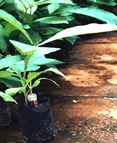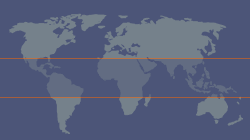We’d like to share our enthusiasm for this unique and special tree.
Teak is a beautiful wood, valued not only for its grain quality and hue but also for its strength and resistance to rot and mold. Teak wood has a multitude of uses, such as the manufacture of outdoor furniture, the best available parquet flooring, sailboat decks, and even electrical insulation in harsh and dry desert conditions.
Teak is a deciduous tree and can grow up to 50 meters high with a girth of well over 1 meter. A mature tree will have a rounded crown and, under favourable conditions, a tall clean cylindrical trunk, which is often buttressed at the base. An older tree’s leaves can be 30 to 60 centimeters long and our broad, younger trees have larger leaves. The trees typically enjoy deep soils that are well drained and rich in calcium. They will flourish where there is an average yearly temperature of 27 degrees Celsius (80 degrees Fahrenheit) and generous rainfall although a 3 to 4 month dry season is also necessary.
Teak is one of the world’s most valuable hardwood varieties. The rare beauty of teak, with its golden brown luster, decorative grain and unique properties have made it one of the most demanded exotic woods of the world.
There are many uses for teak. Teak does not warp, crack or turn black when in contact with metals. It is ideal for marine use and is used for the decks of many sailing vessels.
On land, teak has a multitude of uses, for example, in doors, window frames, sculptures, exterior joinery, interior & exterior furniture, and flooring. The chemical industry recognises many applications for teak because of its durability and resistance to harsh chemicals. Teak has been used extensively in the oil fields of the Middle East as it is the only wood in the world that can withstand harsh, dry desert conditions and not conduct electrical sparks that could cause a deadly explosion.
Another outstanding feature of teak is its ability to withstand all types of climatic conditions. Outdoor teak furniture needs no paint or varnish. Severe winter snowstorms, monsoon rains, and tropical heat cannot diminish the strength of teak. Teak is one of the few woods in the world that has a natural oil to retard water and not warp, crack or become brittle. Teak is extremely resistant to rot and has resins (techno-quinine) that naturally repel termites.
Teak is indigenous to only four countries in the entire world, Burma (Myanmar), Thailand, Laos, and India, all of which have natural teak forests. Natural teak has almost become an endangered tree species. Teak has a very narrow growing zone, and areas suited for vigorous growth are confined to a narrow band around the equator. In addition, the soil must be fertile and teak does not appear to grow well above 1,000 meters.
Teak around the World
With some exceptions, the area shown as a band on the map is generally considered to contain the best regions for growing tropical trees. Teak grows best in equatorial regions (between 20 degrees north and south) which enjoy a specific rainy season but which otherwise have high and consistent year-round temperatures.
For centuries, the ancient kings of Burma and Thailand considered teak to be a Royal Tree under strict royal proclamation and protection. Thailand once had 100 million rai ( 6.25 rai = one hectare) of natural teak forest and now has practically none. Teak logging has been banned in Thailand since 1983 and all teak trees in Burma are under the jurisdiction of the government. Teak forests are tightly controlled by many governments because of their enormous monetary and ecological importance to the nation.
Teak is a precious resource. Burma is the world’s largest exporter of premium teak which constitutes 80% of the world supply. In its natural habitat teak grows sparsely with only one to five trees per acre. In Burma, some forests have been closed due to over felling. Specialists of the Food and Agriculture Organisation (FAO) estimate that as much as 1,500,000 acres may have been devastated. Reckless felling and smuggling across borders have damaged the sustainability of Burma’s teak production. Environmental groups and concerned citizens in America and Europe are mounting pressure to introduce legislation to allow only imports of plantation wood or woods from sustained yield forests. If enacted, this would have a ruinous effect on some teak producing countries but would dramatically increase the value of professionally managed teak plantations….
Teak in Indonesia
Teak is not indigenous to Indonesia but arrived from India courtesy of the Hindu monks in the 14th Century. The Indonesian climate and fertile soils offered ideal growing conditions for the teak tree.
The graph below shows the average rainfall and temperature close to Jakarta in Indonesia which is not far from the GoldTeak Project.
Teak is a good coppice species making it ideal for managed plantation growth. In addition, the ‘techno quinine’ in its resins gives it strong resistance to termites and other parasites. Trees older than 4 years have admirable resistance to fire owing to the quality of the bark. The bark offers an 8 to 12 mm thick, fibrous protective layer which is grey or light greyish brown in color.
Before the onset of the Industrial Revolution, all ships were constructed from hardwood species such as oak or teak. In the northern hemisphere, in early times oak was a very valuable resource, highly prized for building houses on land and ships at sea.
The Dutch, largely deprived of oak in their country, searched for other sources of hardwood from which to build their navies. The discovery of the vast forests in the Far East led to them concentrating their efforts in that area. Almost all natural teak in Indonesia was felled by them, but far from only taking what they needed, the Dutch saw the need to manage the resource, knowing that the tree was very slow-growing. With an age of 50-70 years to maturity, this tree could not be grown within one person’s lifespan, but nevertheless, the Dutch entered into a massive re-forestation program.
The onset of the Industrial Revolution and the building of ‘iron-clad’ ships meant that the future of forest management in Indonesia became less significant, and many plantations were abandoned to forest again. It is largely these ‘secondary’ forests that are being harvested today.
The demand for teak for housing and marine purposes is still there, and there is an increasing demand for teak wood to be used in high quality furniture, but incredible as it may seem, the greatest demand is for pulping for paper, a terrible fate for such a wonderful tree.


